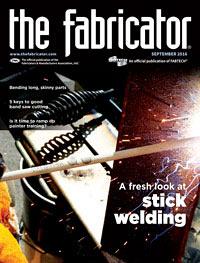CEO
- FMA
- The Fabricator
- FABTECH
- Canadian Metalworking
Categories
- Additive Manufacturing
- Aluminum Welding
- Arc Welding
- Assembly and Joining
- Automation and Robotics
- Bending and Forming
- Consumables
- Cutting and Weld Prep
- Electric Vehicles
- En Español
- Finishing
- Hydroforming
- Laser Cutting
- Laser Welding
- Machining
- Manufacturing Software
- Materials Handling
- Metals/Materials
- Oxyfuel Cutting
- Plasma Cutting
- Power Tools
- Punching and Other Holemaking
- Roll Forming
- Safety
- Sawing
- Shearing
- Shop Management
- Testing and Measuring
- Tube and Pipe Fabrication
- Tube and Pipe Production
- Waterjet Cutting
Industry Directory
Webcasts
Podcasts
FAB 40
Advertise
Subscribe
Account Login
Search
The art and science of metals purchasing
Avoid metals purchasing missteps with superior intelligence and presentation
- By Alan Bear, CPPM, CPP
- August 31, 2016
- Article
- Metals/Materials
Metal fabrication presents high barriers to enterprise entry. The costs of machinery and personnel necessary for success impose restrictively high capital cost demands on a new entry into the marketplace. In addition, material price fluctuations impose additional elements of risk to the already high stakes. Shop owners, managers, and employees all understand that maintaining competitive advantage is paramount to survive in the fabrication world.
Considering the risks, everyone in this industry should aspire to become novice metals purchasing enthusiasts. However, developing a metals pricing strategy must be carefully researched and planned.
That said, negotiation in the metals market functions as both an art and a science. When metals negotiators incorporate both aspects, they help control costs and create an enterprise affording customers seamless service and delivery.
First, the Science
Science in metals purchasing involves understanding the task at hand. Buyers purchase material, of course; however, that grossly oversimplifies the job requirements. Buyers must learn the mechanics of the marketplace in order to function appropriately. The tips below will guide you through the subtleties of the science.
1. Keep up with the news. Metals markets are global, subject to both economic and political forces at local and international levels. To gain an edge on events that could affect pricing a few months out, watch and read the news daily, and follow the financial markets. For instance, Turkey’s attempted coup may shift demand, potentially affecting domestic scrap export prices in the coming months.
2. Global changes affect local prices. Think about the effects of Brexit. A near 9 percent swing in currency value means potential cost reductions available from U.K. suppliers operating in the U.S.
3. Economic conditions vary by region. The U.S. is vast. Shop for material in areas outside your operating territory; this can validate current costs and unearth potential savings. For instance, during the Great Recession, a shop in Minnesota may have found great metals pricing in Illinois with competitive delivery times. Since trucking companies also needed work, freight costs weren’t excessive. Of course today, many years into the economic recovery, this no longer applies. Regardless, to find good purchasing opportunities, be sure to look beyond your backyard.
4. Cost all the factors affecting your purchase. These include freight, finance charges, storage, and processing. If you don’t give them dutiful analysis, any of these items may make what seems like a great deal on the surface turn sour.
5. Learn the customary weight measurements. The ton, or short ton (2,000 lbs.); tonne, or metric ton (2,204 lbs.); and long ton (2,240 lbs.) represent vastly different amounts of weight that could show up on your billing statement. Know which measurement your transaction references. If you load “16 tons,” that’s fine, but is this a short ton, long ton, or metric ton? You might get something completely different from what you expect.
6. Become a subject-matter expert. The marriage of skill and industry knowledge forms the foundation upon which deals are won.
7. Subscribe to commodities journals or market intelligence services. In metals, some journals have been around for more than a century; others are new online startups. Regardless, each provides commodities news vital to developing strategic purchasing intelligence.
8. Become versed in actual versus theoretical weight. Know how your firm buys and whether you can change practices based on volume. And, of course, never, ever change without involving engineering first. Any materials purchasing decision ideally should be a collaborative one within your organization.
If you buy on theoretical weight, based on the theoretical nominal point, you might be paying for more material than you’re actually receiving. Look at your supplier’s catalog and check out the material thickness range.
For instance, 7-gauge hot-rolled from one supplier may have a theoretical nominal point of 0.1793 in., yet the thickness ranges from 0.1713 in. all the way up to 0.1873 in. The difference between the “gauge minimum” of 0.1713 in. to the 0.1793-in. theoretical nominal point can represent a significant price difference.
If your firm has sufficient purchasing power, try negotiating “gauge minimum,” if doing so satisfies engineering requirements.
9. Educate your co-workers on common stock versus stock book items. Service centers often use an A-B-C stock inventory method; you have declining inventory volumes as the letters move down the alphabet. This means not all items in a stocking book exist on the service center floor, and mill lead times may not support project deadlines.
Again, implementing change calls for collaboration between purchasing and engineering. Engineering may see a material in the book that, say, exceeds specific requirements by a large margin. However, upon investigation, they find that the material is a C item, meaning it may not be in stock for quick delivery. Waiting for material may impose job delays, late deliveries, and countless (although your boss will be counting) unintended costs. Sometimes a product may need a specific material to meet design requirements, but not always.
10. Consider value engineering. Can a high-strength, low-alloy material replace bulky structural members? If so, would this yield savings, including reduced labor costs? Again, such changes should happen only with engineering support. Each change needs to consider things such as natural frequency, vibratory mode, stress load, and cycling.
11. Consider all related costs. Decisions in purchasing often cause ripple effects across the entire company. For instance, how does your receiving department receive material off the truck? Are people counting pieces, or are they weighing bundles?
Say a buyer negotiates pricing based on delivered weight, and the employees in receiving weigh the material on a scale. They find the bundles weigh significantly less than what was agreed upon. Subsequently, the respective billing departments debate as to whose material scale is correct. The process takes time and reduces productivity at both organizations. In other words, it costs money on both sides of the transaction, and it’s a cost that can be traced back to agreements made by the buyer.
But what if the buyer and supplier agree to a weight per sheet for a specific size, thickness, and grade? This way, the material vendor ships a number of sheets of certain grades and thicknesses; people in the receiving department count them to verify the order; and the material supplier bills the fabricator based on the contracted weight per sheet.
This strategy may not work in all situations, but when it does, processes gain efficiency and labor for other endeavors. If you purchase large amounts of material at once, you will save time in billing (never debating over the true material weight), but people in receiving will spend hours counting sheets.
Still, this sometimes can uncover another hidden cost: holding large amounts of material and processing large batches. Do you really need to produce so many products at once? Or could the shop deliver smaller batches more frequently and thereby accept smaller quantities of material in the receiving department?
Now, the Art
The art of purchasing adds polish and flare to enlighten the dull world of facts, figures, and strategy discussed previously.
1. Negotiate from a win-win perspective. We’re all in business to make a profit, and this includes your material supplier. Of course, how much profit is fair remains a key consideration that’s open to debate.
2. Suppliers are people too. A skilled negotiator has contacts around the country and treats each as a friend and professional cohort. Learn your contacts’ hobbies, family, and other parts of their lives. You probably have a lot more to talk about than you realize. In fact, if you talk with your supplier contact for 30 minutes, about 25 of those minutes will probably involve talking about their lives; the business part fills the remaining five minutes, sprinkled in as appropriate to fill lulls in conversation.
3. Be available. Avoid phone tag, and respond to your suppliers’ emails. However, always ensure you have a meeting lined up or a call scheduled to prevent negotiations from dragging on past reasonable limits, when frustrations mount. You may wish to dedicate one or two days each month specifically to appointments and calls with your suppliers.
4. The best buyers can’t be bought. Suppliers respect integrity. Refrain from accepting gratuities, asking for tickets, or anticipating paid-for meals.
5. Who are you going to call? Learn who the key decision-makers are at your suppliers and try to speak directly with them. Talking to someone without decision-making authority fuels sales-responsibility negotiation pitfalls. The person you’re talking with may agree to a price, even though he or she lacks authority. Confusion ensues, which again leads to wasted time and money.
6. Be ethical. Never under any circumstance discuss another vendor’s price. Not only is it unethical, it may violate laws. It’s also not in your best interest. Say you tell your supplier that his competitor offered a certain price. That allows the supplier to beat that price just enough to win your business and gain market share—yet still not grant you the best available price. Suppliers typically know the range of competitive price points. Don’t help your supplier oversell you!
A First Step
Following these pointers is just a first step toward purchasing metals effectively. All the same, they provide a valuable path toward developing a personal style and foundation. You can find more information and educational resources from various organizations, including the American Purchasing Society (www.amer ican-purchasing.com).
Developing your purchasing skills will only help make you more effective, your firm more profitable, and your product more competitive. Put another way, superior intelligence combined with superior presentation yields superior results.
About the Author
subscribe now

The Fabricator is North America's leading magazine for the metal forming and fabricating industry. The magazine delivers the news, technical articles, and case histories that enable fabricators to do their jobs more efficiently. The Fabricator has served the industry since 1970.
start your free subscription- Stay connected from anywhere

Easily access valuable industry resources now with full access to the digital edition of The Fabricator.

Easily access valuable industry resources now with full access to the digital edition of The Welder.

Easily access valuable industry resources now with full access to the digital edition of The Tube and Pipe Journal.
- Podcasting
- Podcast:
- The Fabricator Podcast
- Published:
- 04/16/2024
- Running Time:
- 63:29
In this episode of The Fabricator Podcast, Caleb Chamberlain, co-founder and CEO of OSH Cut, discusses his company’s...
- Industry Events
16th Annual Safety Conference
- April 30 - May 1, 2024
- Elgin,
Pipe and Tube Conference
- May 21 - 22, 2024
- Omaha, NE
World-Class Roll Forming Workshop
- June 5 - 6, 2024
- Louisville, KY
Advanced Laser Application Workshop
- June 25 - 27, 2024
- Novi, MI
































